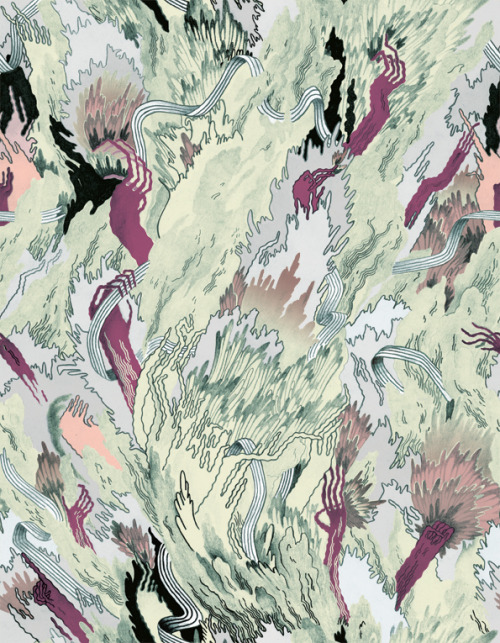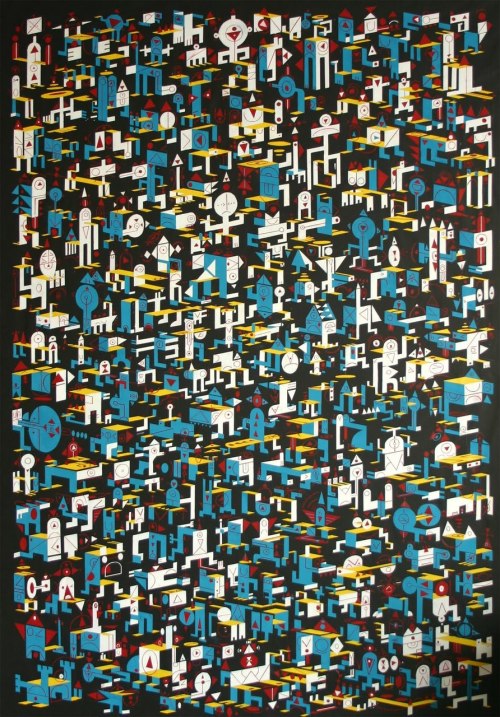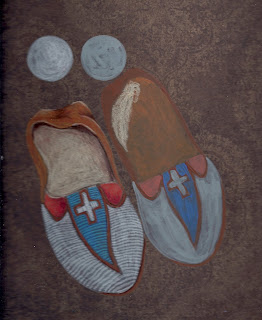One of my veggie prints on a rug... going to put this in my kitchen.
Viewing: Blog Posts Tagged with: prints, Most Recent at Top [Help]
Results 1 - 25 of 48
Blog: Red Fish Circle (Login to Add to MyJacketFlap)
JacketFlap tags: patterns, Add a tag
Blog: OUPblog (Login to Add to MyJacketFlap)
JacketFlap tags: A. R. P. Rau, Beauty of Physics, Patterns Principles Perspectives, Books, patterns, astronomy, physics, electron, quantum physics, *Featured, Physics & Chemistry, laws of physics, Science & Medicine, Add a tag
The aim of physics is to understand the world we live in. Given its myriad of objects and phenomena, understanding means to see connections and relations between what may seem unrelated and very different. Thus, a falling apple and the Moon in its orbit around the Earth. In this way, many things “fall into place” in terms of a few basic ideas, principles (laws of physics) and patterns.
As with many an intellectual activity, recognizing patterns and analogies, and metaphorical thinking are essential also in physics. James Clerk Maxwell, one of the greatest physicists, put it thus: “In a pun, two truths lie hid under one expression. In an analogy, one truth is discovered under two expressions.”
Indeed, physics employs many metaphors, from a pendulum’s swing and a coin’s two-sidedness, examples already familiar in everyday language, to some new to itself. Even the familiar ones acquire additional richness through the many physical systems to which they are applied. In this, physics uses the language of mathematics, itself a study of patterns, but with a rigor and logic not present in everyday languages and a universality that stretches across lands and peoples.
Rigor is essential because analogies can also mislead, be false or fruitless. In physics, there is an essential tension between the analogies and patterns we draw, which we must, and subjecting them to rigorous tests. The rigor of mathematics is invaluable but, more importantly, we must look to Nature as the final arbiter of truth. Our conclusions need to fit observation and experiment. Physics is ultimately an experimental subject.
Physics is not just mathematics, leave alone as some would have it, that the natural world itself is nothing but mathematics. Indeed, five centuries of physics are replete with instances of the same mathematics describing a variety of different physical phenomena. Electromagnetic and sound waves share much in common but are not the same thing, indeed are fundamentally different in many respects. Nor are quantum wave solutions of the Schroedinger equation the same even if both involve the same Laplacian operator.

Along with seeing connections between seemingly different phenomena, physics sees the same thing from different points of view. Already true in classical physics, quantum physics made it even more so. For Newton, or in the later Lagrangian and Hamiltonian formulations that physicists use, positions and velocities (or momenta) of the particles involved are given at some initial instant and the aim of physics is to describe the state at a later instant. But, with quantum physics (the uncertainty principle) forbidding simultaneous specification of position and momentum, the very meaning of the state of a physical system had to change. A choice has to be made to describe the state either in terms of positions or momenta.
Physicists use the word “representation” to describe these alternatives that are like languages in everyday parlance. Just as with languages, where one needs some language (with all equivalent) not only to communicate with others but even in one’s own thinking, so also in physics. One can use the “position representation” or the “momentum representation” (or even some other), each capable of giving a complete description of the physical system. The underlying reality itself, and most physicists believe that there is one, lies in none of these representations, indeed residing in a complex space in the mathematical sense of complex versus real numbers. The state of a system in quantum physics is in such a complex “wave function”, which can be thought of either in position or momentum space.
Either way, the wave function is not directly accessible to us. We have no wave function meters. Since, by definition, anything that is observed by our experimental apparatus and readings on real dials, is real, these outcomes access the underlying reality in what we call the “classical limit”. In particular, the step into real quantities involves a squared modulus of the complex wave functions, many of the phases of these complex functions getting averaged (blurred) out. Many so-called mysteries of quantum physics can be laid at this door. It is as if a literary text in its ur-language is inaccessible, available to us only in one or another translation.

What we understand by a particle such as an electron, defined as a certain lump of mass, charge, and spin angular momentum and recognized as such by our electron detectors is not how it is for the underlying reality. Our best current understanding in terms of quantum field theory is that there is a complex electron field (as there is for a proton or any other entity), a unit of its excitation realized as an electron in the detector. The field itself exists over all space and time, these being “mere” markers or parameters for describing the field function and not locations where the electron is at an instant as had been understood ever since Newton.
Along with the electron, nearly all the elementary particles that make up our Universe manifest as particles in the classical limit. Only two, electrically neutral, zero mass bosons (a term used for particles with integer values of spin angular momentum in terms of the fundamental quantum called Planck’s constant) that describe electromagnetism and gravitation are realized as classical electric and magnetic or gravitational fields. The very words particle and wave, as with position and momentum, are meaningful only in the classical limit. The underlying reality itself is indifferent to them even though, as with languages, we have to grasp it in terms of one or the other representation and in this classical limit.
The history of physics may be seen as progressively separating what are incidental markers or parameters used for keeping track through various representations from what is essential to the physics itself. Some of this is immediate; others require more sophisticated understanding that may seem at odds with (classical) common sense and experience. As long as that is kept clearly in mind, many mysteries and paradoxes are dispelled, seen as artifacts of our pushing our models and language too far and “identifying” them with the underlying reality, one in principle out of reach. We hope our models and pictures get progressively better, approaching that underlying reality as an asymptote, but they will never become one with it.
Headline Image credit: Milky Way Rising over Hilo by Bill Shupp. CC-BY-2.0 via shupp Flickr
The post Patterns in physics appeared first on OUPblog.
Blog: Illustration for Kids Blog (Login to Add to MyJacketFlap)
JacketFlap tags: children, Illustration, comics, cartoon, icons, owl, pattern, owls, paula j. becker, patterns, paula becker, Add a tag
Playing with owls and patterns...
Blog: Bit by Bit (Login to Add to MyJacketFlap)
JacketFlap tags: Surface Pattern Design, Turkish ornamentation, TRAVEL, Inspiration, patterns, Istanbul, decorative, Add a tag
I'm on a special holiday in Turkey, celebrating my father's 80th birthday, in the beautiful city of Istanbul. Walking down the wide avenues and into history, one of the first things I noticed of course (once I'd recovered from the overwhelming gloriousness of it all) was the ornamentation - patterns galore everywhere I looked; and colour, decorative ornamentation, flowers ... patterns patterns patterns.
I've only managed to post a few of my photographic captures here, hoping that they'll inspire you as well ... my creative soul is dancing with delight in this country. I shall have to visit again one day, for longer than one too-short week.
I've barely had time to breathe never mind draw anything, but have tons of ideas to work on once when I get back on Monday. I'll be posting pics of the city itself as well soon, and more ... meanwhile, you'll have to forgive me if things are a bit erratic in here for ... well, for a while yet.
Wishing you a glorious week. Cheers from Istanbul.
Blog: Miss Marple's Musings (Login to Add to MyJacketFlap)
JacketFlap tags: picture books, nonfiction, patterns, snakes, Reptiles, teaching resources, Perfect Picture Book Friday, Roxi Munro, Add a tag
Title: Slithery Snakes Story and art by Roxie Munro Published by Amazon Publishing, 2013 Ages: 7-11 Themes: snakes, habitats, skin patterns Nonfiction, 40 pages. Available in hard back and eBook formats. Opening Lines: Can you guess what kind of snake this is? … Continue reading
Add a CommentBlog: the dust of everyday life (Login to Add to MyJacketFlap)
JacketFlap tags: PATTERNS, THEMED ART, Patrick Girouard, Add a tag
Blog: the dust of everyday life (Login to Add to MyJacketFlap)
JacketFlap tags: laundry, color, boats, PATTERNS, house, Italy, canal, bike, Sharon Vargo, obelisk, Add a tag
Burano Italy is one of my favorite places... full of color and patterns.
Blog: the dust of everyday life (Login to Add to MyJacketFlap)
JacketFlap tags: PATTERNS, R.W. Alley, THEMED ART, Add a tag
Blog: the dust of everyday life (Login to Add to MyJacketFlap)
JacketFlap tags: black cat, treat or treat, Halloween, ghosts, PATTERNS, candy., Add a tag
I have to say I love patterns, so when asked to do a halloween illustration, all I could think about was the scenario and patterns. So here is my offering, the ghosts are friendly and handing out treats to the little treat or treaters.
With patterns... Read the rest of this post
Blog: Illustration for Kids Blog (Login to Add to MyJacketFlap)
JacketFlap tags: kids, flowers, cartoon, comic, children's art, icons, eggs, spring, bunny, easter, patterns, paula becker, whimsical, cut, Add a tag
Thought I'd put up some Easter-related items here, since we are into March. This is part of a licensing package I've been working on.

Blog: DIANE SMITH: Illo Talk (Login to Add to MyJacketFlap)
JacketFlap tags: flowers, rock, journey, contemplation, painting, concept, prayer, river, patterns, water, listen, quiet, palette, exploring, paths, pthalo blue, phthalo green, El Capitan State Beach, Add a tag
I've tucked away the porcelain creamer, little orange flowers and cascading drapery, replacing the objects with photo references for a project I'm really excited about doing. The inspiration was a photograph of my oldest daughter taken about a year ago at El Capitan State Beach. However, I'm changing the location from a rocky beach to a rocky riverbed with some trees in the background.
I'm looking forward to playing with some colors that have not been on the palette for other projects - mainly Phthalo blue and green. I'm also excited about exploring colors and patterns of stones in water - I've always been drawn to that in nature. But, most of all, I'm delighted to be working with a specific concept - trying to capture the moment of quiet contemplation or listening in prayer.
I have flashes of what I think the end product might look like, but I've learned not to get hung up in those fleeting visions. They give me a direction, but the journey will likely take me down any number of possible paths. But, this is merely a study for the sake of exploration. Ultimately, I see this as a fairly large painting - large for my space, anyway, requiring more than a little tabletop. By the time I'm ready to move on to canvas, the weather should be comfortable enough to work in the garage again.
Blog: Bit by Bit (Login to Add to MyJacketFlap)
JacketFlap tags: Doodles, Digital Art, surface design, creative exercises, patterns, Marker pens, Surface Pattern Design, ABSPD, blue leaf pattern, blue leaves pattern, Add a tag
More creative exercises to play with. This time I picked up my black pen and scribbled unplanned 'marks' on a page, then decided they somewhat resembled leaves and so drew a whole lot of those, spacing them out in a grid. After which I sketched out their outlines, and finally, still exploring and playing (couldn't stop myself!), I added colour.
The original marks were made on paper but I scanned that and the outlines were worked on in Photoshop. I filled the colour in with marker pens on paper as well, and that too was then scanned in and finished up in Adobe Photoshop. Had tons of fun.
Now I just have to figure out what my next step might be ... Cheers!
Blog: Read Now Sleep Later (Login to Add to MyJacketFlap)
JacketFlap tags: fishgirl182, Thuy, MillbrookPress, JaneBrocket, children's books, Picture book, book review, nonfiction, children's, patterns, 3 stars, netgalley, Add a tag
Category: Children’s Non-Fiction Picture Book
Keywords: Children’s, non-fiction, picture book, patterns
Format: Hardcover
Source: Netgalley
Spotty, Stripey, Swirly is one of the newest additions to author Jane Brocket’s Clever Concepts line of non-fiction picture books. Like her other books, this one is not traditionally illustrated but is filled with photos that Brocket has taken herself. As you can tell from the title Spotty, Stripey, Swirly is about finding and recognizing patterns all around us.
Stripes, dots, zig zags, and circles abound, punctuated by Brocket’s signature style of bright, colorful photographs. Using eye catching photos, Brocket teaches children what a pattern is and how to recognize them. She urges them to find patterns in everyday objects. From simple to complex, patterns are everywhere if you just know where to look. This would be a nice addition to a very young child’s library.
 |
| say "twee"! |
Blog: Kid Lit Reviews (Login to Add to MyJacketFlap)
JacketFlap tags: NetGalley, Lerner Publishing Group, 5stars, 4stars, A to Z Challenge 2012, Carolehoda Books, Children's Books, Millbrook Press, patterns, Graphic Universe, leaves, Add a tag
A to Z Challenge Day 14: N Netgalley is a blogger’s dream. Whether you are beginning, or just cannot get the books you need to review, NetGalley is the best place to join. Anyone who runs a book review site, any genre or age group, will find the books they need. Netgalley and Lerner Publishing [...]![]()
Blog: Kid Lit Reviews (Login to Add to MyJacketFlap)
JacketFlap tags: nonfiction children's books, 4stars, Children's Books, NonFiction, patterns, Add a tag
4 Stars Dotty, stripy, straight, and swirly—patterns are all around us. How many different patterns can you find pictured in this book? Wow! For younger children this is a challenge right out of Where’s Waldo? I am still counting as I write this. Wow! Flowers, furniture, toys, sidewalks, anything you might see all have patterns. [...]![]()
Blog: DRAWN! (Login to Add to MyJacketFlap)
JacketFlap tags: Jake Pauls, patterns, Add a tag

An impressive repeating pattern, perfect for your desktop wallpaper, by Jake Pauls.
Blog: DRAWN! (Login to Add to MyJacketFlap)
JacketFlap tags: illustration, colour, patterns, Migy, Add a tag

Migy’s illustrations make me go YES YES YES!
Blog: DRAWN! (Login to Add to MyJacketFlap)
JacketFlap tags: illustration, Disney, patterns, abstract, Gerben Steenks, Add a tag

Dutch illustrator/animator Gerben Steenks shows off some serious abstract/pattern-making skills. Gerben also works for Disney Consumer Products, bringing his mad vision to the House of Mouse:

Blog: studio lolo (Login to Add to MyJacketFlap)
JacketFlap tags: acrobat, illustration friday, harlequin, patterns, raven, studio lolo, Add a tag
Blog: studio lolo (Login to Add to MyJacketFlap)
JacketFlap tags: illustration friday, patterns, studio lolo, moccasins, cheyenne, Add a tag
Blog: Ginger Pixels (Login to Add to MyJacketFlap)
JacketFlap tags: Ginger Nielson, clothes, closet, patterns, queen, Add a tag
Since this is a fantasty Queen or a Story Book Queen, nothing really needs to match. It just needs to be so much FUN!
Blog: studio lolo (Login to Add to MyJacketFlap)
JacketFlap tags: fabric, patterns, spoonflower, studio lolo, mandala, waterblossoms, Add a tag
Blog: studio lolo (Login to Add to MyJacketFlap)
JacketFlap tags: patterns, rust, studio lolo, six word saturday, patina, wrought iron, Add a tag
Blog: Picture Bookies (Login to Add to MyJacketFlap)
JacketFlap tags: kids, Ginger Nielson, patterns, Add a tag





Blog: Picture Bookies (Login to Add to MyJacketFlap)
JacketFlap tags: Ginger Nielson, Painter, patterns, Add a tag





View Next 22 Posts



















This is lovely and bright, a tonic against the grey weather we have today :)